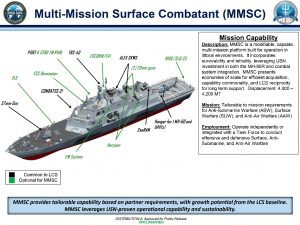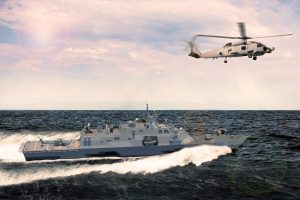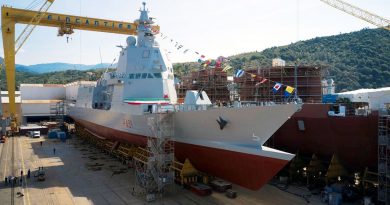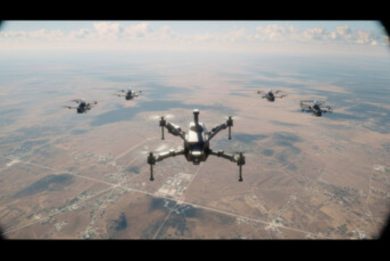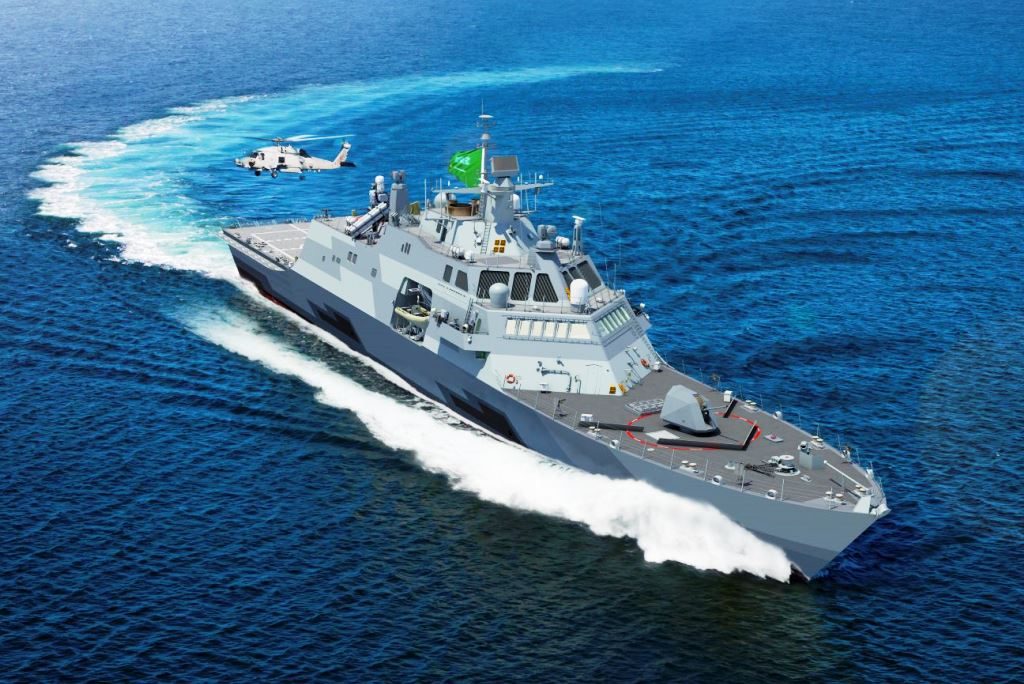
Lockheed Martin: new milestones and developments for Saudi MMSC programme
The Royal Saudi Naval Force’s (RSNF) Multi-Mission Surface Combatant (MMSC) programme, also known as ”Twaiq Project” and managed by Lockheed Martin as prime contractor, is progressing according to schedule, with new developments being introduced based on customer requirements.
Speaking to EDR On-Line at the Euronaval 2022 exhibition Dawn Brenner, Lockheed Martin small combatants and ship systems business development director, confirmed that the keel for second-of-class Fahd (822) was laid down on 13 October and fabrication of ships three and four is underway. Fahd’s keel laying follows that of first-of-class Saud (820) in May 2021.
The four ships under order for the RSNF are being built at Fincantieri Marinette Marine shipyard in Wisconsin in collaboration with Lockheed Martin as prime contractor. The ships, derived from the Freedom variant of the Littoral Combat Ship (LCS) already in service with the US Navy, are being procured by the Kingdom of Saudi Arabia under a US Foreign Military Sales (FMS) case to form the backbone of a recapitalized RSNF eastern fleet.
Retaining the same 118 meters hull and combined diesel and gas propulsion system, the MMSC departs from the mission module concept and instead embodies full multi-mission warfighting capabilities including anti-air warfare (AAW), anti-surface warfare (ASuW) and anti-submarine warfare (ASW), the latter with the single MH-60R helicopter that can be operated and accommodated/supported by the stern flight deck and hangar. The RSNF MMSC will have a ship complement of 101 including 84 personnel as crew core and 17 for the helicopter detachment. Accommodations are available for additional 29 people.
The MMSC combat system is centred on Lockheed Martin’s COMBATSS 21 combat management system derived from the Aegis common source library. The current sensors suite includes a Hensoldt TRS-4D 3D AESA multifunction rotating radar, IFF, a communication suite with data Link 16, two Saab Ceros 200 fire control directors, EW suite, ALEX SKWS decoy launchers in addition to an AN/SLQ-25 torpedo decoy system, among others. The weapon package includes a BAE Systems Mk 110 57 mm medium-calibre gun, a Lockheed Martin Mk 41 vertical launch system with eight cells (plus space and accommodation for three additional cells) for surface-to-air missiles, an 11-round Raytheon Mk 15 Mod 31 SeaRAM inner layer defence system, two Nexter Narwhal 20 mm remote control stations, two quadruple launchers for Boeing RGM-84 Harpoon Block II anti-ship missiles, and two Mk 32 multiple torpedo launchers.
The RSNF MMSC’s sensors and weapon packages are however currently subjected to modifications and enhancements according to the Lockheed Martin representative, responding to a specific question by EDR On-Line. “We have (so far) maintained the (current) configuration through the first four ships. Based on customer requests, we recently signed a case amendment and expect a contract to add and integrate the MBDA CAMM (Common Anti-Air Missile) weapon system, new Electronic Warfare (EW) capabilities as well as the Link 22,” she highlighted. The modification contract will be assigned to Lockheed Martin by the US Naval Sea Systems Command (NAVSEA), following the signed Government-to-Government modification agreement to original ships configuration.
The MBDA CAMM will be integrated with the COMBATSS 21 combat management system and launching system starting with the second ship to be followed by the third and the fourth, while the first will be retrofitted without indicating a timeline. “We have done a lot of work over the years with MBDA to integrate the CAMM with the Mk 41, and more recently we have together completed the qualification of the CAMM with the low-cost compact Lockheed Martin Extensible Launching System (ExLS) 3-Cell Stand Alone Launcher. Main efforts will be therefore devoted to integrate the CAMM weapon into the COMBATSS 21,” said Joe DePietro, Lockheed Martin’s vice president and general manager of naval combat and missile defence systems.
With the addition of the MBDA CAMM, four of which can be accommodated in each of the Mk41 cells, and its integration with the COMBATSS 21 CMS, the RSNF will provide the MMSC with the principal air defence capability against saturation attacks in highly-dense electronic environments. The CAMM missile is equipped with an active RF seeker with midcourse flight update provided by a two-way data link between the missile and the launcher, eliminating the need for fire control/illumination radars.
The EW system will be announced once the case amendment contract will be awarded.
The addition of the Link 22 secure beyond-line-of-sight communication capability will increase joint and coalition communications in the surface, sub-surface, land, and air domains, and will provide unprecedented situational awareness across the battle space. Inherent Link 22 performance benefits include its self-healing network ability, increased user availability, longer range, and interoperability with Link 11 and Link 16, coupled with new modernized crypto, offering capability growth for future mission sets.
The Lockheed Martin representative also highlighted that the company is supporting the US Navy FMS case training scope with the development of a Land Based Test and Training systems package.
In Q4 2023, according to US Navy documentation, the first-of-class is scheduled to be delivered by Lockheed Martin to the International Unmanned and Small Combatants Program Office (PMS 525), the organization responsible for the acquisition and implementation of the FMS case. The ship will then be transferred on the Atlantic Coast from Fincantieri Marinette Marine shipyard on Lake Michigan, remaining in the US in Mayport facilities for another 12 months for post-delivery test and trials, post shakedown availability, and dedicated RNSF crew training, in preparation for the formal delivery and ship transfer to Saudi Arabia. Here the four MMSC will be based near Jubail on the Gulf coast at the King Abdul-Aziz Naval Base, which infrastructures are being prepared to welcome and support the new naval platforms.
Lockheed Martin is also focused on localisation efforts with the RSNF, and Brenner highlighted the maintenance repair and overhaul (MRO) project as an illustrative example of the company’s commitment to its partnerships with Saudi Arabian industry. Moreover the company is actively working to identify new systems and capabilities.
As Lockheed Martin looks to the future for MMSC variants, enhanced EW capability could be provided via the same company’s AN/SLQ-32C(V)6 SEWIP (Surface Electronic Warfare Improvement Program) Lite suite. Through internal research and development, US Navy investment and support, and partnerships with the Naval Research Laboratory and the Office of Naval Research, Lockheed Martin developed and produced a smaller SEWIP Block 2. This scaled variant, about half the size of the SEWIP, is specifically tailored for the needs of small ships, such as LCS, Offshore Patrol Cutter and National Security Cutter, to address fleet emergent needs for a robust, capable, and sustainable EW system that meets the space, weight and power limitations of these platforms. The system provides early detection, analysis, threat warning, and protection from anti-ship missiles. The SEWIP Lite is capable of both littoral and open ocean electronic surveillance. Upgrades to the antenna, receiver, and combat system interface allow the SEWIP to pace new threats. The system also features improved signal detection, measurement accuracies, and classification, in addition to mitigate electromagnetic interference. While being procured for Coast Guard vessels, future MMSCs could be the first combatant platforms to receive the system, which provides a significant enhancement compared to the current RESM suite.
Images courtesy Lockheed Martin and US Navy

